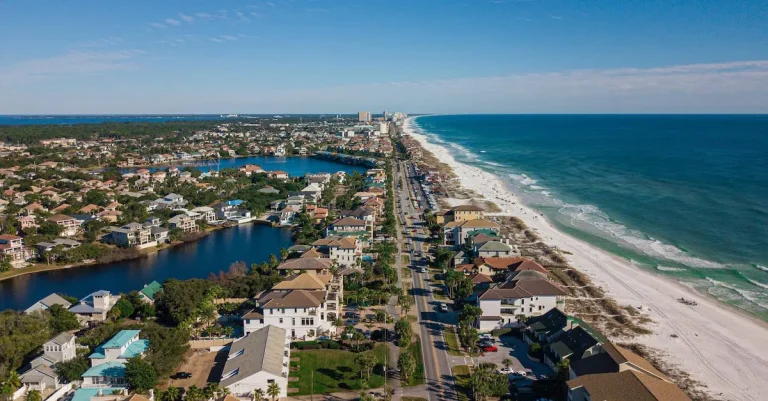Could California Fall Into The Ocean During A Bad Earthquake?
The thought of the entire state of California breaking off and falling into the Pacific Ocean is a terrifying prospect. As unlikely as it may seem, many wonder if a massive earthquake could actually cause this catastrophic scenario. If you’re short on time, here’s a quick answer to your question: While parts of the California coast could slip into the ocean during a very large earthquake, the entire state detaching and falling in is virtually impossible based on current scientific understanding.
In this comprehensive article, we will analyze the geologic forces at play and examine if and how California’s coastline could be altered by a severe seismic event. We’ll review the earthquake risks facing the state, explain why the Hollywood disaster movie image of California sinking is unrealistic, and discuss more probable local impacts along the coast. By the end, you’ll have a much clearer understanding of the real earthquake hazards California faces.
Examining California’s Earthquake Risks and Fault Lines
California is known for its beautiful coastlines, stunning landscapes, and vibrant cities. However, living in the Golden State comes with a certain level of risk – earthquakes. With its location along the Pacific Ring of Fire, California experiences frequent seismic activity.
While the thought of the state falling into the ocean during a bad earthquake might sound dramatic, it is important to understand the actual risks and the network of faults that crisscross the region.
Overview of California’s network of faults
California is home to a complex network of faults, which are fractures in the Earth’s crust where rocks on either side have moved. These faults are responsible for the majority of earthquakes in the state.
Some of the well-known faults include the San Andreas Fault, Hayward Fault, and the Calaveras Fault. These faults are not straight lines but rather have intricate patterns that can span for hundreds of miles.
The California Geological Survey has identified over 500 active faults in the state, with many more yet to be discovered. These faults are categorized based on their size and potential for seismic activity.
While some faults are considered more active than others, it is crucial to note that earthquakes can occur on any fault at any time.
San Andreas Fault and its earthquake history
When discussing earthquakes in California, it is impossible not to mention the San Andreas Fault. Running roughly 800 miles from the Salton Sea in Southern California to Cape Mendocino in Northern California, this fault is the most well-known in the state.
The San Andreas Fault has a long history of producing large earthquakes, with the infamous 1906 San Francisco earthquake being one of the most destructive.
Scientists have closely studied the San Andreas Fault to understand its behavior and the potential for future earthquakes. While it is difficult to predict exactly when and where the next major earthquake will occur, experts agree that the San Andreas Fault is capable of producing a significant quake in the future.
This is why earthquake preparedness and ongoing research are essential for Californians.
Other major faults capable of producing damaging quakes
In addition to the San Andreas Fault, California is home to several other major faults that have the potential to generate damaging earthquakes. The Hayward Fault, located in the San Francisco Bay Area, is considered one of the most dangerous faults due to its proximity to densely populated areas.
The southern section of the San Jacinto Fault, which runs through Southern California, is another significant fault that poses a seismic risk. The Puente Hills Fault, located near Los Angeles, is also a concern due to its potential for strong ground shaking.
It is important for residents of California to be aware of these other major faults and the potential risks they present. Understanding the seismic activity in the region can help individuals and communities take appropriate measures to mitigate the impact of earthquakes.
For more information on California’s earthquake risks and preparedness, visit the California Department of Conservation’s website.
Why California Falling into the Ocean is Nearly Impossible
California sits on the border of two tectonic plates
California is located in a region known as the “Ring of Fire,” where several tectonic plates meet. Specifically, the state is situated on the boundary between the Pacific Plate and the North American Plate.
This unique geological setting means that California experiences a high frequency of earthquakes, but it does not necessarily imply that the state is at risk of falling into the ocean.
Plate motions produce stresses relieved by quakes
The movement of tectonic plates is responsible for the creation of earthquakes. As the Pacific Plate and the North American Plate interact, stress slowly builds up along their boundaries. Eventually, this stress is released in the form of an earthquake.
While California is indeed prone to seismic activity, it is important to note that these earthquakes are caused by the movement of the plates and are not indicative of the state falling into the ocean.
Even massive quakes don’t displace entire plates
It is a common misconception that a massive earthquake could cause California to break off and sink into the ocean. However, this notion is not supported by scientific evidence. Even the largest earthquakes, such as the 1906 San Francisco earthquake or the more recent 1994 Northridge earthquake, do not have the capacity to displace entire tectonic plates.
While these earthquakes can cause significant damage and loss of life, they do not pose a threat of California falling into the ocean.
More Realistic Local Impacts Along California’s Coast
Parts of coast could experience subsidence during very large quakes
While the idea of California falling into the ocean during a bad earthquake may be a popular myth, there are still realistic local impacts that can occur along the state’s coast. One such impact is subsidence, which refers to the sinking or downward movement of the Earth’s surface.
During very large earthquakes, certain parts of the coast could experience subsidence due to the shifting of tectonic plates beneath the surface.
This subsidence can lead to a variety of problems, such as damage to infrastructure, flooding, and changes in the coastal landscape. It is important to note that not all areas along the coast are equally susceptible to subsidence, and the severity of the subsidence can vary depending on the magnitude and location of the earthquake.
Examples of past local subsidence events
There have been several notable instances of subsidence along California’s coast in the past. One well-known example is the 1906 San Francisco earthquake, which caused significant subsidence in areas near the epicenter.
The ground in parts of San Francisco dropped by as much as 2.5 meters (8.2 feet), leading to widespread destruction and loss of life.
Another example is the 1964 Alaska earthquake, which triggered a tsunami that caused subsidence along the California coast. In Crescent City, the land dropped by approximately 1.4 meters (4.6 feet), resulting in extensive damage to the city’s harbor and infrastructure.
Other seismic threats like tsunamis
In addition to subsidence, California’s coast is also vulnerable to other seismic threats, such as tsunamis. Tsunamis are large ocean waves that can be triggered by undersea earthquakes or landslides. When these waves reach the shore, they can cause widespread devastation, particularly in low-lying coastal areas.
It is essential for coastal communities to have robust emergency preparedness plans in place to mitigate the impact of tsunamis. Early warning systems, evacuation routes, and public education initiatives can help save lives and minimize damage during a tsunami event.
For more information on earthquake preparedness and safety measures, you can visit the Earthquake Country Alliance website. They provide valuable resources and guidelines to help individuals and communities be better prepared for seismic events.
Steps Californians Can Take to Prepare
Living in California means living with the constant threat of earthquakes. While the idea of the state falling into the ocean during a bad earthquake may be more myth than reality, it’s still important to be prepared for any seismic activity.
Here are some steps Californians can take to ensure their safety:
Have an earthquake preparedness plan and kit
One of the most important steps you can take is to have an earthquake preparedness plan in place. This includes knowing what to do during an earthquake, such as “Drop, Cover, and Hold On,” as well as having a designated meeting place for your family in case you get separated.
Additionally, it’s crucial to have an emergency kit stocked with essentials like non-perishable food, water, flashlights, batteries, and a first aid kit. The Ready.gov website is a great resource for creating a comprehensive earthquake preparedness plan.
Retrofit homes to improve seismic resilience
Another important step is to retrofit your home to improve its seismic resilience. This involves reinforcing the structure of your home to better withstand the forces of an earthquake. Some common retrofitting techniques include bolting the house to the foundation, reinforcing cripple walls, and adding bracing to the chimney.
Retrofitting not only improves the safety of your home but can also help reduce damage and repair costs. The California Earthquake Authority website provides valuable information on retrofitting and offers resources to help homeowners make their homes more resilient.
Know tsunami evacuation routes if you live along the coast
If you live along the coast, it’s crucial to be aware of tsunami evacuation routes. Tsunamis can be triggered by undersea earthquakes and can pose a significant threat to coastal communities. Familiarize yourself with the designated evacuation routes in your area and have a plan in place for how you will evacuate in the event of a tsunami warning.
The National Tsunami Warning Center provides up-to-date information on tsunamis and offers resources to help you prepare for this specific type of natural disaster.
By taking these steps, Californians can better prepare themselves for the possibility of earthquakes and mitigate the potential risks associated with seismic activity. Remember, being prepared can make all the difference in ensuring the safety and well-being of yourself and your loved ones.
Conclusion
While the doomsday scenario of California falling into the ocean is more Hollywood than reality, major earthquakes still pose serious risks for the state. Understanding the actual seismic hazards allows Californians to better prepare. With prudent planning and preparedness, communities can build resilience against the earthquake risks facing the Golden State.








